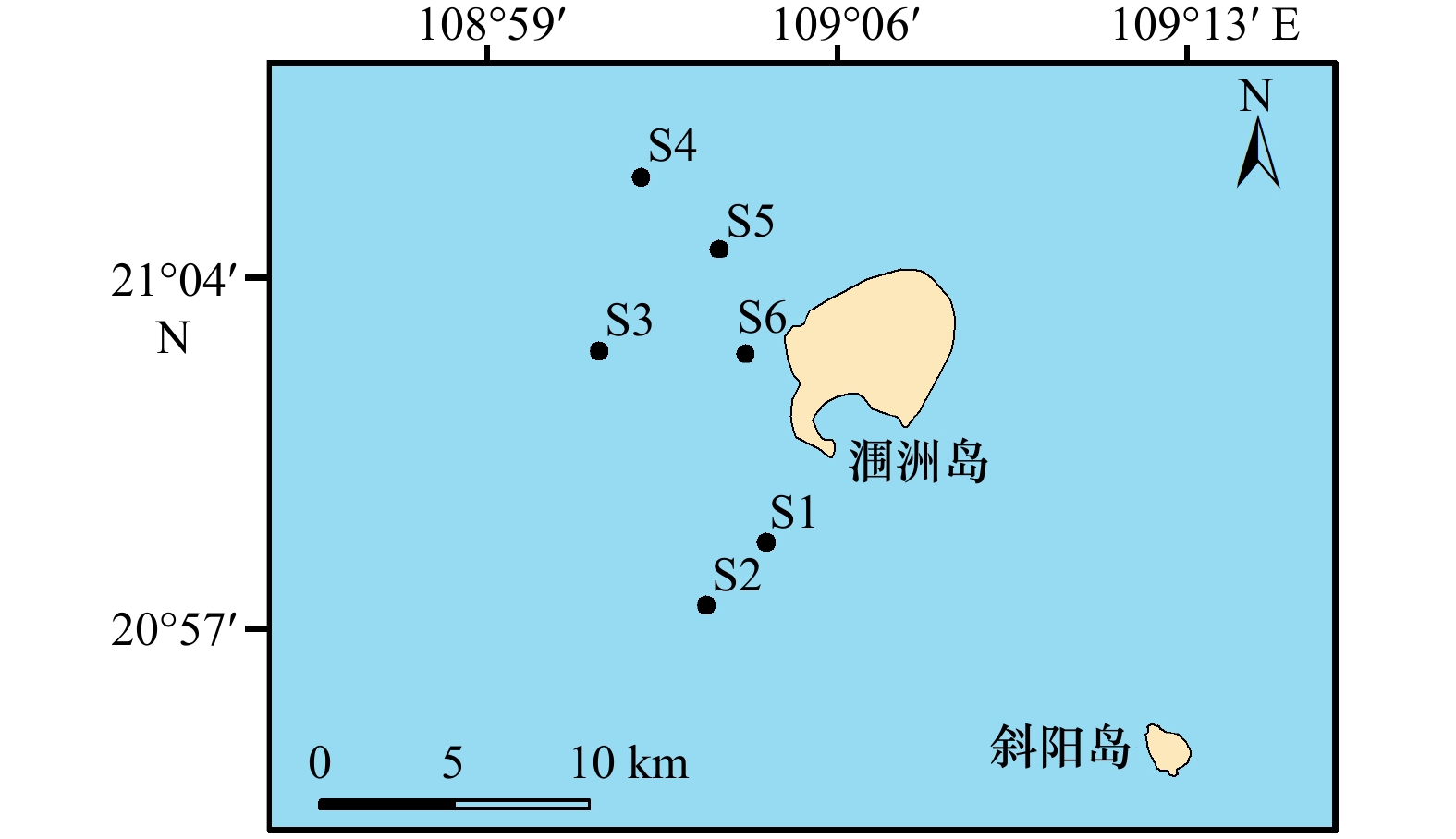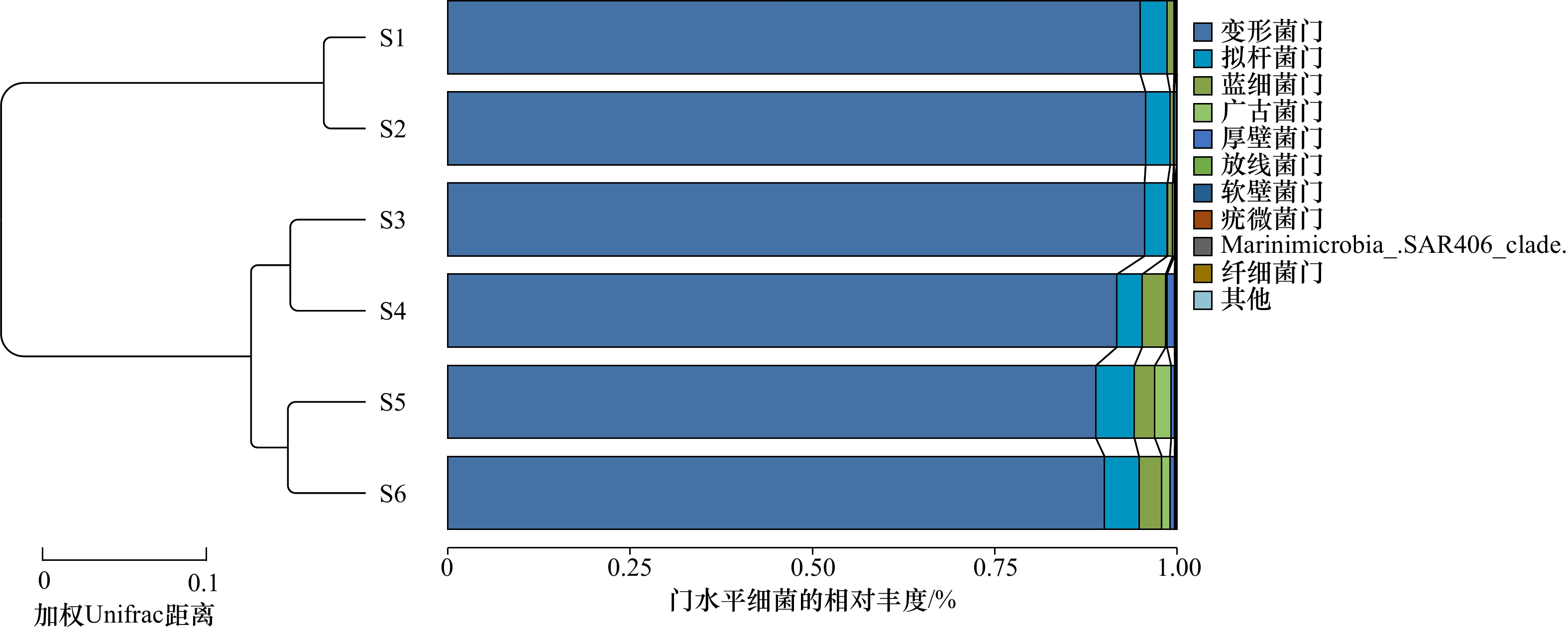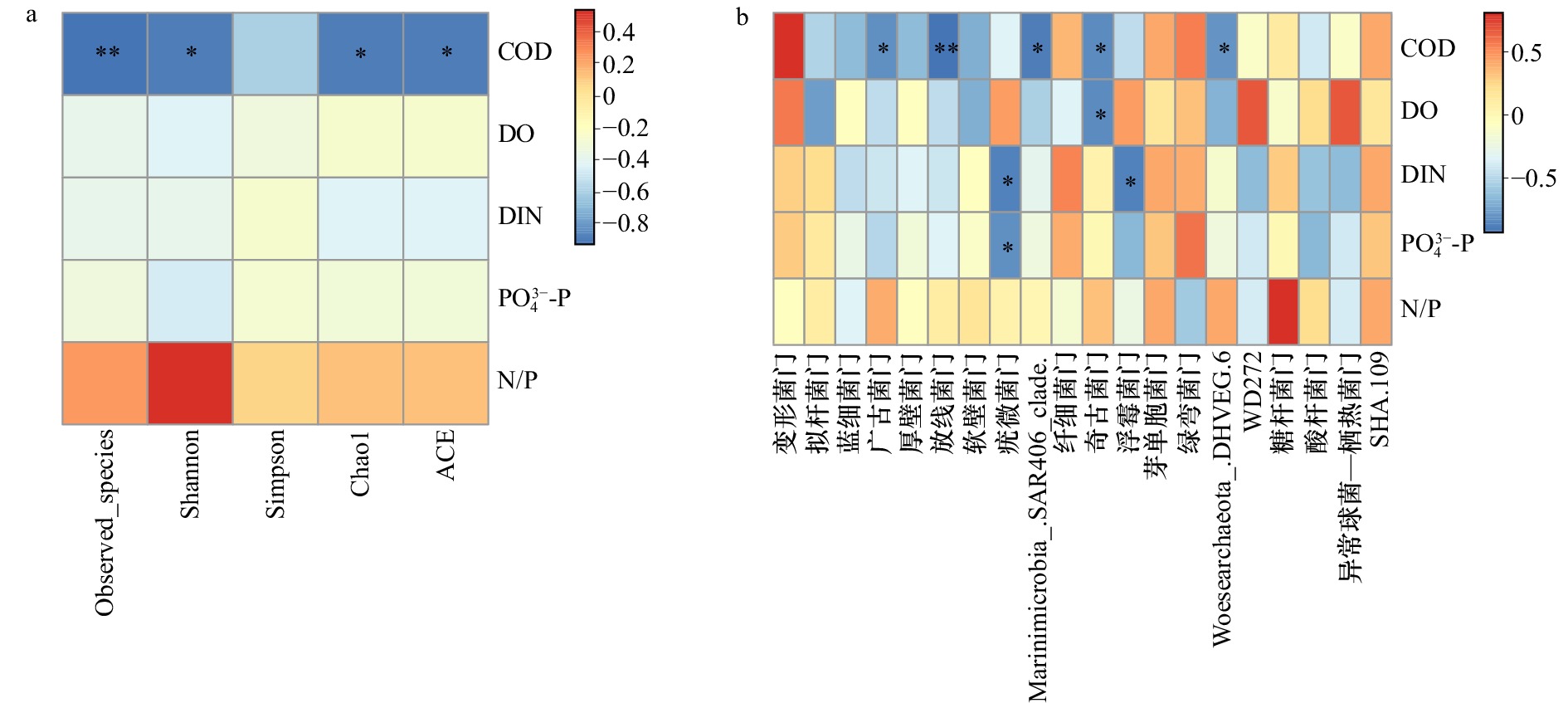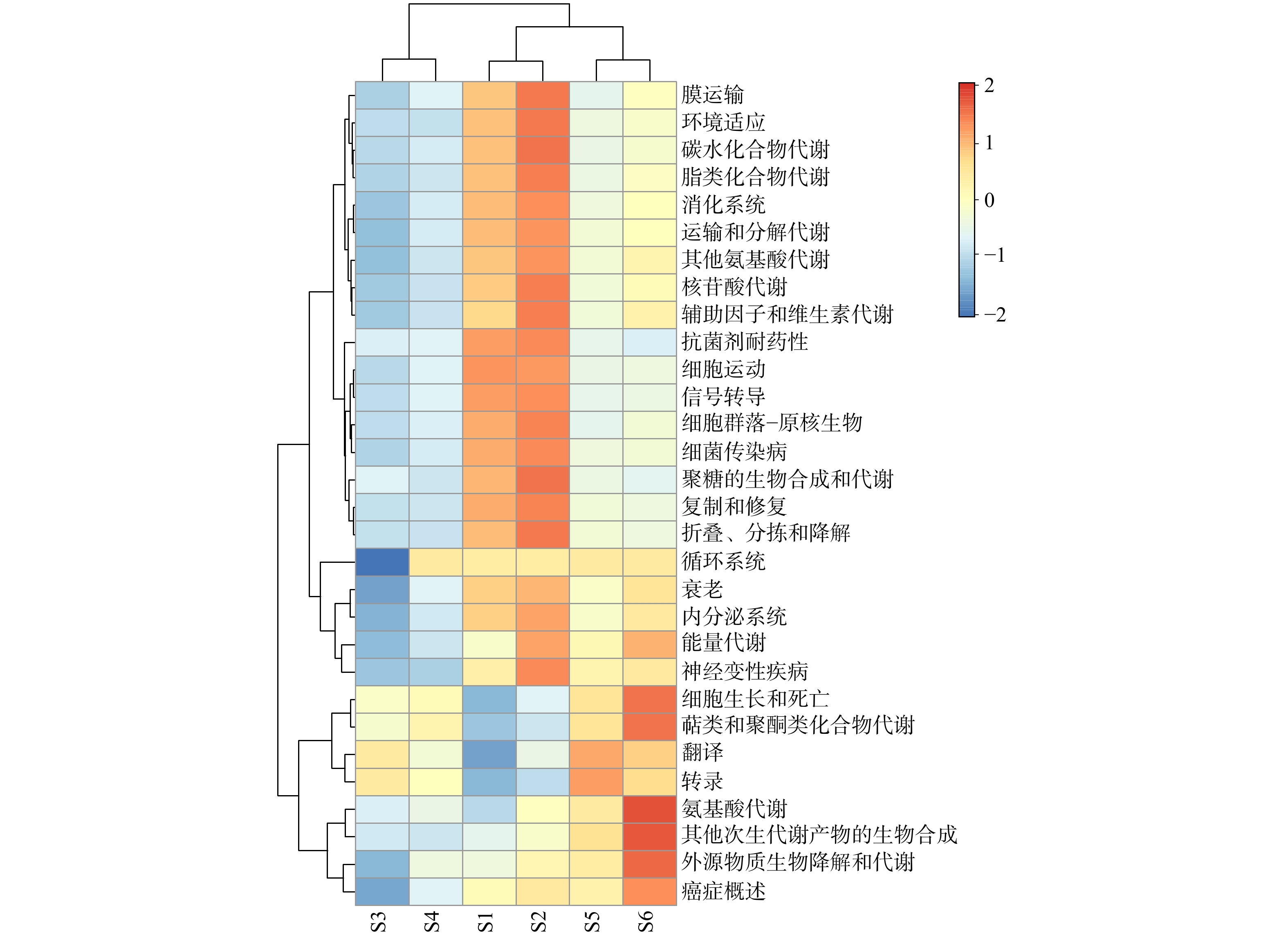Analysis of phytoplankton and bacterial community during the first recorded massive Noctiluca scintillans bloom in the Beibu Gulf, China
-
摘要: 北部湾位于南海西北部,最近30年赤潮暴发频率、持续时间和范围正经历显著增长。为了了解北部湾大规模夜光藻赤潮期间的浮游植物和细菌群落特征,于2021年2月21日在涠洲岛西部首次大规模夜光藻暴发海域采集海水样品,对环境因子、浮游植物和细菌群落进行了研究。结果表明:该海域水质符合一类海水水质标准,主要为绝对P限制状态,结合近年来其他研究指出的非赤潮期间,涠洲岛邻近及北部湾中部海域为贫营养及主要为P限制,可推断本次夜光藻赤潮属于一次非富营养化下发生的赤潮。海水中共鉴定出浮游植物2门5属5种,其中夜光藻(Noctiluca scintillans)为绝对优势种,其细胞密度为2.00×103~3.75×103 cells/L。结合现场水色,可确定本次赤潮生物为红色异养型夜光藻。系统发育和遗传距离分析则表明本次赤潮原因种属于我国沿海常见的夜光藻株系。对海水样品细菌16S rRNA基因 V3−V4区高通量测序发现海水细菌群落操作分类单元(OTU)数量为294~414,以α-变形菌纲(Alphaproteobacteria)和γ-变形菌纲(Gammaproteobacteria)为优势菌群;细菌群落结构受COD、DO、DIN、
${\rm{PO}}_4^{3-}$ −P、N/P多种环境因子的影响,其中COD为主要影响因子。研究结果可为明确北部湾大规模夜光藻赤潮期间的环境特征、微生物组成及海洋生态保护提供科学依据。Abstract: Beibu Gulf is located in the northwestern part of the South China Sea and is experiencing a significant increase in the frequency, duration and extent of harmful algal blooms (HABs) outbreaks in the last 30 years. To characterize phytoplankton and bacterial communities during the massive Noctiluca scintillans bloom in the Beibu Gulf, seawater samples were collected from the area of a massive N. scintillans outbreak west from Weizhou Island on February 21, 2021, and environmental factors, along with phytoplankton and bacterial communities were analyzed. The results showed that the sea water quality of this area met the standards of Chinese Class I seawater quality, mainly in the absolute phosphate limit state. In recent years, other studies reported low nutrient content and limited phosphorus in waters adjacent to Weizhou Island and in the central part of Beibu Gulf during the non-harmful algal bloom (HAB) period. Therefore, N. scintillans bloom investigated in this study belonged to a non-eutrophication HAB event. Two phyla, five genera, and five species of phytoplankton were identified in seawater, among which N. scintillans was the absolute dominant species, with a cell density of 2.00×103–3.75×103 cells/L. The red discoloration of the sea water was caused by the red heterotrophic N. scintillans. Both phylogenetic and genetic distance analyses demonstrated that the causative N. scintillans in the Beibu Gulf was similar to N. scintillans along the coast of China. High-throughput sequencing of the V3–V4 region of the 16S rRNA gene in seawater samples revealed that the number of OTUs (operational taxonomic units) in bacterial community ranged from 294 to 414, with Alphaproteobacteria and Gammaproteobacteria as the dominant groups. The bacterial community structure was affected by various environmental factors, including COD, DO, DIN,${\rm{PO}}_4^{3-} $ -P, and N/P, among which COD was predominant. This research provides new insights into the environmental characteristics and microbial composition of sea water during a massive N. scintillans bloom and will aid bloom management in the Beibu Gulf.-
Key words:
- Noctiluca scintillans bloom /
- phytoplankton /
- bacterial community /
- environmental factors /
- Beibu Gulf
-
表 1 北部湾大规模夜光藻赤潮期间涠洲岛西部海域环境因子
Tab. 1 Environmental factors in the western part of Weizhou Island during the the massive Noctiluca scintillans bloom in the Beibu Gulf
监测站位 pH 盐度 COD/
(mg∙L−1)DO浓度/
(mg∙L−1)DIN浓度/
(mg∙L−1)${{\rm {PO}}_4^{3-}} $-P浓度/
(mg∙L−1)Chl a浓度/
(μg∙L−1)TN浓度/
(mg∙L−1)TP浓度/
(mg∙L−1)富营养化指数 N/P S1 8.21 31.1 0.72 8.04 0.125 0.007 <0.5 0.398 0.014 0.140 39.5 S2 8.24 31.2 0.69 8.10 0.064 0.003 <0.5 0.376 0.014 0.029 47.2 S3 8.23 31.1 0.67 8.19 0.039 0.002 1.1 0.327 0.019 0.012 43.2 S4 8.24 31.3 0.60 8.27 0.036 0.002 0.8 0.293 0.016 0.010 39.9 S5 8.21 31.3 0.44 7.84 0.046 0.002 1.7 0.222 0.009 0.009 50.9 S6 8.20 31.2 0.33 7.70 0.057 0.003 <0.5 0.243 0.009 0.013 42.1 均值 8.22 31.20 0.58 8.02 0.06 0.003 0.7 0.310 0.014 0.036 44.3 注:“<”表示数据未检出,其后数据为检出限;<0.5的样品均值以0.25计算。 表 2 浮游植物组成及密度
Tab. 2 Phytoplankton compositon and density
优势种 细胞密度/(cells∙L−1) S1站位 S3站位 夜光藻 Noctiluca scintillans 2.00×103 3.75×103 钟扁甲藻Pyrophacus horologicum 0 4.17×102 叉角藻 Ceratium furca 4.76×102 0 异角盒形藻 Biddulphia heteroceros 4.76×102 0 菱形海线藻 Thalassionema nitzschioides 0 8.33×102 合计 2.95×103 5.00×103 表 3 各站位OTUs数量和Alpha多样性指数
Tab. 3 OTUs number and Alpha diversity related indices at stations S1−S6
站位 有效序列 OTU Shannon Simpson Chao 1 ACE Coverage/% PD S1 121 338 294 4.008 0.867 310.081 318.118 100.00 26.544 S2 129 860 329 4.136 0.856 319.895 324.875 100.00 28.339 S3 132 140 322 4.028 0.846 318.000 317.332 100.00 37.902 S4 129 906 379 4.498 0.883 367.882 373.329 100.00 45.817 S5 135 346 378 4.829 0.915 380.750 385.921 100.00 43.080 S6 133 870 414 4.588 0.881 417.000 415.785 100.00 45.073 均值 130 410 353 4.348 0.875 352.268 355.893 100.00 37.793 -
[1] Harrison P J, Furuya K, Glibert P M, et al. Geographical distribution of red and green Noctiluca scintillans[J]. Chinese Journal of Oceanology and Limnology, 2011, 29(4): 807−831. doi: 10.1007/s00343-011-0510-z [2] Tsai S F, Wu Luying, Chou Wenchen, et al. The dynamics of a dominant dinoflagellate, Noctiluca scintillans, in the subtropical coastal waters of the Matsu archipelago[J]. Marine Pollution Bulletin, 2018, 127: 553−558. doi: 10.1016/j.marpolbul.2017.12.041 [3] 中华人民共和国国家海洋局. HY/T 069−2005, 赤潮监测技术规程[S]. 北京: 中国标准出版社, 2005.State Oceanic Administration of the People's Republic of China. HY/T 069-2005, Technical specification for red tide minitoring[S]. Beijing: Standards Press of China, 2005. [4] 周名江, 朱明远, 张经. 中国赤潮的发生趋势和研究进展[J]. 生命科学, 2001, 13(2): 54−59, 53. doi: 10.3969/j.issn.1004-0374.2001.02.002Zhou Mingjiang, Zhu Mingyuan, Zhang Jing. Status of harmful algal blooms and related research activities in China[J]. Chinese Bulletin of Life Sciences, 2001, 13(2): 54−59, 53. doi: 10.3969/j.issn.1004-0374.2001.02.002 [5] Zhang Shuwen, Xia Xiaomin, Ke Ying, et al. Population dynamics and interactions of Noctiluca scintillans and Mesodinium rubrum during their successive blooms in a subtropical coastal water[J]. Science of the Total Environment, 2021, 755: 142349. doi: 10.1016/j.scitotenv.2020.142349 [6] Guo Hao, Liu Xiaoxu, Ding Dewen, et al. The economic cost of red tides in China from 2008−2012[J]. PICES Scientific Report, 2014(47): 27−34. [7] Lao Qibin, Su Qizhong, Liu Guoqiang, et al. Spatial distribution of and historical changes in heavy metals in the surface seawater and sediments of the Beibu Gulf, China[J]. Marine Pollution Bulletin, 2019, 146: 427−434. doi: 10.1016/j.marpolbul.2019.06.080 [8] Xu Yixiao, Zhang Teng, Zhou Jin. Historical occurrence of algal blooms in the northern Beibu Gulf of China and implications for future trends[J]. Frontiers in Microbiology, 2019, 10: 451. doi: 10.3389/fmicb.2019.00451 [9] 罗金福, 李天深, 蓝文陆. 北部湾海域赤潮演变趋势及防控思路[J]. 环境保护, 2016, 44(20): 40−42.Luo Jinfu, Li Tianshen, Lan Wenlu. Evolution trend and prevention strategy of algae bloom in the Beibu Gulf[J]. Environmental Protection, 2016, 44(20): 40−42. [10] 科学网. 海洋一号C/D卫星发现北部湾夜光藻赤潮[EB/OL]. (2021−02−19)[2022−10−24]. https://news.sciencenet.cn/htmlnews/2021/2/453258.shtm.ScienceNet. Noctiluca scintillans bloom was detected in the Beibu Gulf by HY-1C/1D[EB/OL]. (2021−02−19)[2022−10−24]. https://news.sciencenet.cn/htmlnews/2021/2/453258.shtm. [11] 中国自然资源报. 自然资源部南海局开展突发赤潮应急监测[EB/OL]. (2021−02−24)[2022−10−24]. https://m.thepaper.cn/baijiahao_11444325.China Natural Resources News. The South China Sea Bureau of the Ministry of Natural Resources of China carried out emergency monitoring of sudden red tide[EB/OL]. (2021−02−24)[2022−10−24]. https://m.thepaper.cn/baijiahao_11444325. [12] Fu Shaoqiong, Lou Xiulin, Yang Jingsong, et al. Multi-satellite observation of a harmful algal bloom in the Beibu Gulf, South China Sea[C]//Proceedings of 2021 Photonics & Electromagnetics Research Symposium (PIERS). Hangzhou: IEEE, 2021: 2329−2335. [13] Wang Weicheng, Sun Song, Sun Xiaoxia, et al. Seasonal phenology of the heterotrophic dinoflagellate Noctiluca scintillans (Macartney) in Jiaozhou Bay and adjacent coastal Yellow Sea, China[J]. Journal of Oceanology and Limnology, 2018, 36(4): 1280−1293. doi: 10.1007/s00343-018-6350-3 [14] Chen Yao, Zhang Yao, Jiao Nianzhi. Responses of aerobic anoxygenic phototrophic bacteria to algal blooms in the East China Sea[J]. Hydrobiologia, 2011, 661(1): 435−443. doi: 10.1007/s10750-010-0553-8 [15] Song Junting, Bi Hongsheng, Cai Zhonghua, et al. Early warning of Noctiluca scintillans blooms using in-situ plankton imaging system: an example from Dapeng Bay, P. R. China[J]. Ecological Indicators, 2020, 112: 106123. doi: 10.1016/j.ecolind.2020.106123 [16] Miyaguchi H, Fujiki T, Kikuchi T, et al. Relationship between the bloom of Noctiluca scintillans and environmental factors in the coastal waters of Sagami Bay, Japan[J]. Journal of Plankton Research, 2006, 28(3): 313−324. doi: 10.1093/plankt/fbi127 [17] Gibson K, Song Huiyin, Chen Nansheng. Metabarcoding analysis of microbiome dynamics during a Phaeocystis globosa bloom in the Beibu Gulf, China[J]. Harmful Algae, 2022, 114: 102217. doi: 10.1016/j.hal.2022.102217 [18] Wang Jinxiu, Kong Fanzhou, Geng Huixia, et al. CHEMTAX analysis of phytoplankton assemblages revealed potential indicators for blooms of haptophyte Phaeocystis globosa[J]. Ecological Indicators, 2021, 131: 108177. doi: 10.1016/j.ecolind.2021.108177 [19] 中华人民共和国国家质量监督检验检疫总局, 中国国家标准化管理委员会. GB 17378−2007, 海洋监测规范[S]. 北京: 中国标准出版社, 2008.General Administration of Quality Supervision, Inspection and Quarantine of the People's Republic of China. GB 17378−2007, The specification for marine monitoring[S]. Beijing: Standards Press of China, 2008. [20] 中华人民共和国环境保护部. HJ 442−2008, 近岸海域环境监测规范[S]. 北京: 中国环境科学出版社, 2009.Ministry of Environmental Protection of the People's Republic of China. HJ 442−2008, Specification for offshore environmental monitoring[S]. Beijing: China Environmental Press, 2009. [21] Nelson D M, Brzezinski M A. Kinetics of silicic acid uptake by natural diatom assemblages in two Gulf Stream warm-core rings[J]. Marine Ecology Progress Series, 1990, 62(3): 283−292. [22] Dortch Q, Whitledge T E. Does nitrogen or silicon limit phytoplankton production in the Mississippi River plume and nearby regions?[J]. Continental Shelf Research, 1992, 12(11): 1293−1309. doi: 10.1016/0278-4343(92)90065-R [23] Justić D, Rabalais N N, Turner R E, et al. Changes in nutrient structure of river-dominated coastal waters: stoichiometric nutrient balance and its consequences[J]. Estuarine, Coastal and Shelf Science, 1995, 40(3): 339−356. doi: 10.1016/S0272-7714(05)80014-9 [24] Pan Yongbo, Wang Lu, Zhang Wenjing, et al. Genetic analysis of Noctiluca scintillans populations indicates low latitudinal differentiation in China but high China–America differences[J]. Journal of Experimental Marine Biology and Ecology, 2016, 477: 31−39. doi: 10.1016/j.jembe.2016.01.002 [25] 国家环境保护局. GB 3097−1997, 海水水质标准[S]. 北京: 中国环境科学出版社, 2004.National Environmental Protection Agency. GB 3097−1997, Marine water quality standard[S]. Beijing: China Environmental Press, 2004. [26] Mohamed Z A, Mesaad I. First report on Noctiluca scintillans blooms in the Red Sea off the coasts of Saudi Arabia: consequences of eutrophication[J]. Oceanologia, 2007, 49(3): 337−351. [27] Chang K H, Amano A, Miller T W, et al. Pollution study in Manila Bay: eutrophication and its impact on plankton community[M]//Obayashi Y, Isobe T, Subramanian A, et al. Interdisciplinary Studies on Environmental Chemistry-Environmental Research in Asia. Tokyo: Terrapub, 2009: 261−267. [28] 李萍, 郭钊, 莫海连, 等. 广西近岸海域营养盐时空分布及潜在性富营养化程度评价[J]. 海洋湖沼通报, 2018(3): 148−156.Li Ping, Guo Zhao, Mo Hailian, et al. Temporal and spatial distribution of Guangxi inshore nutrients and evaluation of its potential eutrophication[J]. Transactions of Oceanology and Limnology, 2018(3): 148−156. [29] 韩丽君, 郑新庆, 蓝文陆, 等. 近10年涠洲岛周边海域表层海水营养盐含量变化特征[J]. 应用海洋学学报, 2015, 34(1): 65−72. doi: 10.3969/J.ISSN.2095-4972.2015.01.009Han Lijun, Zheng Xinqing, Lan Wenlu, et al. Variations of nutrients concentration in surface seawater in adjacent area of Weizhou Island in recent 10 years[J]. Journal of Applied Oceanography, 2015, 34(1): 65−72. doi: 10.3969/J.ISSN.2095-4972.2015.01.009 [30] 杨幸幸, 杨颖, 许彩燕, 等. 福建和浙江海域夜光藻赤潮2009—2019年的变化及主要环境因子分析[C]//第三届海洋开发与管理学术年会论文集. 北京: 海洋出版社, 2019: 76−83.Yang Xingxing, Yang Ying, Xu Caiyan, et al. Changes and main environmental factors of Noctiluca scintillans blooms in Fujian and Zhejiang waters from 2009-2019[C]// Proceedings of the 3rd Annual Conference on Ocean Development and Management. Beijing: China Ocean Press, 2019: 76−83. [31] Huang Changjiang, Qi Yuzao. The abundance cycle and influence factors on red tide phenomena of Noctiluca scintillans (Dinophyceae) in Dapeng Bay, the South China Sea[J]. Journal of Plankton Research, 1997, 19(3): 303−318. doi: 10.1093/plankt/19.3.303 [32] 于美波, 朱文博, 王君霞, 等. 日照市近岸夜光藻生消特征及其与水温和营养盐的关联[J]. 海洋湖沼通报, 2022, 44(3): 65−70.Yu Meibo, Zhu Wenbo, Wang Junxia, et al. Generation and elimination characteristics of Noctiluca scientillans inhabiting Rizhao near coast and their associations with seawater temperature and nutrients[J]. Transactions of Oceanology and Limnology, 2022, 44(3): 65−70. [33] 天气网. 涠洲岛2021年2月份历史天气[EB/OL]. https://lishi.tianqi.com/weizhoudao/202102.html.www. tianqi. com. Weizhou Island in February 2021 historical weather[EB/OL]. https://lishi.tianqi.com/weizhoudao/202102.html [34] Kopuz U, Feyzioglu A M, Valente A. An unusual red-tide event of Noctiluca scintillans (Macartney) in the Southeastern Black Sea[J]. Turkish Journal of Fisheries and Aquatic Sciences, 2014, 14(1): 261−268. [35] 尹翠玲, 张秋丰, 邹涛, 等. 渤海湾天津近岸海域夜光藻赤潮生消过程初探[J]. 海洋湖沼通报, 2013(2): 99−104.Yin Cuiling, Zhang Qiufeng, Zou Tao, et al. Analysis for Noctiluca scintillans red tide in Bohai bay[J]. Transactions of Oceanology and Limnology, 2013(2): 99−104. [36] Isinibilir M, Kideys A E, Tarkan A N, et al. Annual cycle of zooplankton abundance and species composition in Izmit Bay (the northeastern Marmara Sea)[J]. Estuarine, Coastal and Shelf Science, 2008, 78(4): 739−747. doi: 10.1016/j.ecss.2008.02.013 [37] Baliarsingh S K, Lotliker A A, Trainer V L, et al. Environmental dynamics of red Noctiluca scintillans bloom in tropical coastal waters[J]. Marine Pollution Bulletin, 2016, 111(1/2): 277−286. [38] Valiadi M, de Rond T, Amorim A, et al. Molecular and biochemical basis for the loss of bioluminescence in the dinoflagellate Noctiluca scintillans along the west coast of the U. S. A.[J]. Limnology and Oceanography, 2019, 64(6): 2709−2724. doi: 10.1002/lno.11309 [39] Wang Lu, Lin Xin, Goes J I, et al. Phylogenetic analyses of three genes of Pedinomonas noctilucae, the green endosymbiont of the marine dinoflagellate Noctiluca scintillans, reveal its affiliation to the order Marsupiomonadales (Chlorophyta, Pedinophyceae) under the reinstated name Protoeuglena noctilucae[J]. Protist, 2016, 167(2): 205−216. doi: 10.1016/j.protis.2016.02.005 [40] Wang Lu, Zhuang Yunyun, Zhang Huan, et al. DNA barcoding species in Alexandrium tamarense complex using ITS and proposing designation of five species[J]. Harmful Algae, 2014, 31: 100−113. doi: 10.1016/j.hal.2013.10.013 [41] Litaker R W, Vandersea M W, Kibler S R, et al. Recognizing dinoflagellate species using ITS rDNA sequences[J]. Journal of Phycology, 2007, 43(2): 344−355. doi: 10.1111/j.1529-8817.2007.00320.x [42] 丁玉, 宋秀贤, 曹西华, 等. 不同类型改性粘土去除米氏凯伦藻(Karenia mikimotoi)后絮体中细菌变化特点[J]. 海洋科学, 2021, 45(7): 46−56. doi: 10.11759/hykx20200312001Ding Yu, Song Xiuxian, Cao Xihua, et al. Variation of bacteria in flocs after removal of Karenia mikimotoi by different types of modified clay[J]. Marine Sciences, 2021, 45(7): 46−56. doi: 10.11759/hykx20200312001 [43] Xia Xiaomin, Leung S K, Cheung S, et al. Rare bacteria in seawater are dominant in the bacterial assemblage associated with the bloom-forming dinoflagellate Noctiluca scintillans[J]. Science of the Total Environment, 2020, 711: 135107. doi: 10.1016/j.scitotenv.2019.135107 [44] Zhou Jin, Lao Yongmin, Song Junting, et al. Temporal heterogeneity of microbial communities and metabolic activities during a natural algal bloom[J]. Water Research, 2020, 183: 116020. doi: 10.1016/j.watres.2020.116020 [45] 王勋功, 李迎, 甄毓, 等. 基于454和Illumina高通量测序平台对长江口邻近海域沉积物微生物群落的比较分析[J]. 海洋环境科学, 2018, 37(5): 766−772,791. doi: 10.12111/j.cnki.mes20180521Wang Xungong, Li Ying, Zhen Yu, et al. Comparative analysis of microbial community in the sediments from the adjacent area of Yangtze Estuary by 454 pyrosequencing and Illumina sequencing[J]. Marine Environmental Science, 2018, 37(5): 766−772,791. doi: 10.12111/j.cnki.mes20180521 [46] 常虹, 王博, 姚蜜蜜, 等. 深圳大鹏湾海域锥状斯氏藻赤潮期间细菌群落结构变化研究[J]. 现代生物医学进展, 2014, 14(10): 1801−1807.Chang Hong, Wang Bo, Yao Mimi, et al. Structural dynamic of bacterial community associated with a Scrippsiella trochoidea bloom in Dapeng Bay of shenzhen[J]. Progress in Modern Biomedicine, 2014, 14(10): 1801−1807. [47] 李祎, 杨彩云, 李东, 等. 厦门海域2011年中肋骨条藻和血红哈卡藻赤潮期间细菌群落结构变化[J]. 微生物学报, 2012, 52(10): 1268−1281.Li Yi, Yang Caiyun, Li Dong, et al. Dynamics of bacterial community during the bloom caused by Skeletonema costatum and Akashiwo sanguinea in Xiamen sea area[J]. Acta Microbiologica Sinica, 2012, 52(10): 1268−1281. [48] Li Nan, Zhao Huaxian, Jiang Gonglingxia, et al. Phylogenetic responses of marine free-living bacterial community to Phaeocystis globosa bloom in Beibu Gulf, China[J]. Frontiers in Microbiology, 2020, 11: 1624. doi: 10.3389/fmicb.2020.01624 [49] Lu H P, Yeh Y C, Shiah F K, et al. Evolutionary constraints on species diversity in marine bacterioplankton communities[J]. The ISME Journal, 2019, 13(4): 1032−1041. doi: 10.1038/s41396-018-0336-1 [50] 王加鹏, 崔正国, 周强, 等. 人工湿地净化海水养殖外排水效果与微生物群落分析[J]. 渔业科学进展, 2014, 35(6): 1−9. doi: 10.11758/yykxjz.20140601Wang Jiapeng, Cui Zhengguo, Zhou Qiang, et al. Removal effect of mariculture wastewater and analysis of microbial communities in constructed wetlands[J]. Progress in Fishery Sciences, 2014, 35(6): 1−9. doi: 10.11758/yykxjz.20140601 [51] 赵旺, 黄星美, 邓正华, 等. 夏季美济礁潟湖养殖区海水细菌多样性及其与环境因子的相关性[J]. 中国水产科学, 2022, 29(5): 720−731.Zhao Wang, Huang Xingmei, Deng Zhenghua, et al. Analysis of bacterial diversity and correlation with environmental factors in the aquaculture area of Mischief Reef Lagoon in summer[J]. Journal of Fishery Sciences of China, 2022, 29(5): 720−731. [52] Zhou Jin, Richlen M L, Sehein T R, et al. Microbial community structure and associations during a marine dinoflagellate bloom[J]. Frontiers in Microbiology, 2018, 9: 1201. doi: 10.3389/fmicb.2018.01201 -







 下载:
下载:








